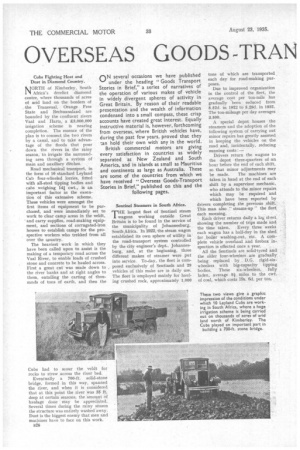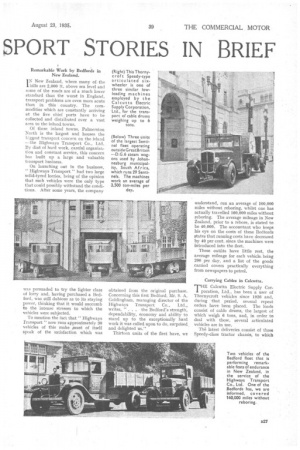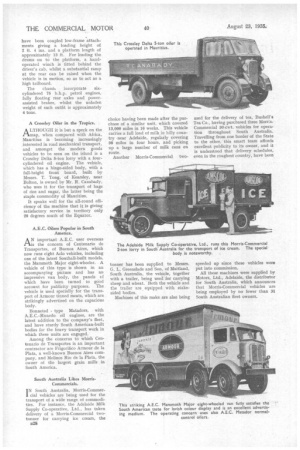OVERSEAS GOODS -TRAN
Page 36

Page 37

Page 38

If you've noticed an error in this article please click here to report it so we can fix it.
SPORT STORIES IN BRIEF
Cubs Fighting Heat and Dust in Diamond Country.
MORTH of Kimberley, South 'Africa's derelict diamond centre, where thousands of acres of arid land on the borders of the Transvaal, Orange Free State and Bechuanaland are bounded by the confluent rivers Vaal and Hartz, a 23,000,000 irrigation scheme is nearing completion. The essence of the plan is to connect the two rivers by a canal, and to take advantage of the floods that pour down the rivers in the rainy season, to irrigate the surrounding area through a system of main and auxiliary ditches.
Road mechanical transport, in the form of 10 standard Leyland Cub four-wheeled lorries, fitted with all-steel tipping bodies and cabs weighing 141 cwt., is an important factor in the execution of this extensive scheme. These vehicles were amongst the first items of equipment to be purchased, and were immediately set to work to clear camp areas in the veldt, and carry supplies, road-making equipment, and sections of corrugated-iron houses to establish camps for the prospective workers who trekked from all over the country.
The heaviest work in which they have been called upon to assist is the making of a temporary road across the Vaal River, to enable loads of crushed stone and concrete to be hauled across. First a great cut was made down to the river banks and at right angles to them, entailing the carting of thousands of tons of earth, and then the
Cubs had to scour the veldt for rocks to strew across the river bed.
Eventually a 700-ft. solid-stone bridge, formed in this way, spanned the river, and when it is considered that at this point the river was 35 ft. deep at certain seasons, the amount of haulage done may be appreciated. Several times during the rainy season the structure was entirely washed away. Dust is the biggest enemy that men and machines have to face on this work.
B26 Sentinel Steamers in South Africa.
THE largest fleet of Sentinel steam wagons working outside Great Britain is to be found in the service of the municipality of Johannesburg, South Africa. In 1922; the steam wagon established its own sphere of utility in the road-transport system controlled by the city engineer's dept.. Johannesburg, and, at the beginning, three different makes of steamer were put into service. To-day, the fleet is composed exclusively of Sentinels and 29 vehicles of this make are in daily use. The fleet is employed mainly for hauling crushed rock, approximately 1,000
tons of which are transported, each day for road-making purposes.
Due to improved organization in the control of the fleet, the average cost per ton-mile has gradually been reduced from 8.52d. in 1922 to 5.29d. in 1932. The ton-mileage per day averages 3,500.
A special depot houses the steamers and the adoption of the following system of carrying out minor repairs has greatly assisted in keeping the vehicles on the road and, incidentally, reducing running costs :— Drivers return the wagons to tbe depot three-quarters of an hour before the end of each shift, so that minor adjustments may be made. The machines are taken in hand at the end of each shift by a supervisor mechanic, who attends to the minor repairs which may be required and which have been reported by drivers completing the previous shift.. This man also " steams-up " the fleet each morning.
Each driver returns daily a log sheet. showing the number of trips made and the time taken. Every three weeks each wagon has a half-day in the shed for boiler washing-out,. etc. A complete vehicle overhaul and firebox in-. spection is effected once a year.
All the Sentinels are solid-tyred and the older four-wheelers are gradually being replaced by D.G. rigid-sixwheelers with big-capacity tipping bodies. These six-wheelers, fully laden, average 9it miles to the cwt. of coal, which costs 19s. 6d. per ton.
Remarkable Work by Bedfords in New Zealand.
I N New Zealand, where many of. the hills are 2,000 ft. above sea level and some of the roads are of a much lower standard than the worst in England, transport problems are even more acute than in this country. The commodities which are constantly arriving at the five chief ports have to be collected and distributed over a vast area to the inland towns.
Of these inland towns, Palmerston North is the largest and houses the biggest transport concern on the island —the Highways Transport Co., Ltd. By dint of hard work, careful organization and constant service, this concern has built up a large and valuable transport business.
On launching out in the business, " Highways Transport " had two large solid-tyred lorries, being of the opinion that such vehicles were the only type that could possibly withstand the conditions. After some years, the company was persuaded to try the lighter class of lorry and, having purchased a Bedford, was still dubious as to its staying power, thinking that it would succumb to the intense stresses to which the vehicles were subjected.
To mention the fact that " Highways rransport "now runs approximately 30 vehicles of this make .must of itself speak of the satisfaction which was obtained from the original purchase, Concerning this first Bedford, Mr. S. A. Goldingham, managing director of the Highways Transport Co., Ltd., writes, " . . the Bedford's strength, dependability, economy and ability to stand up to the exceptionally hard work it was called upon to do, surprised and delighted us."
Thirteen units of the fleet have, we understand, run an average of 100,000 miles without reboring, whilst one has actually travelled 160,000 miles without reboring. The average mileage in New Zealand, prior to a rebore, is stated to be 40,000. The accountant who keeps his eye on the costs of these Bedfords states that running costs have decreased by 40 per cent. since the machines were introduced into the fleet.
These outfits have little rest, the average mileage for each vehicle. being 200 per day, and a list of the goods carried covers practically everything from newspapers to petrol.
Carrying Cables in Calcutta.
THE Calcutta Electric Supply Corporation, Ltd., has been a user of Thornycroft vehicles since 1926 and, during that period, several repeat orders have been placed. The loads consist of cable drums, the largest of Which weigh 6 tons, and, in order to deal with these, several articulated vehicles are in use.
Th latest deliveries consist of three Speedy-class tractor chassis, to which
have been coupled low-frame -attachments giving a loading height of 2 ft. 4 ins, and a platform length of approxiniately 13 ft. For loading the drums on to the platform, a handoperated winch is fitted behind the driver's cab, whilst a substantial ramp at the rear can be raised when the vehicle is in motion, so as to act as a high tailboard.
The chassis incorporate sixcylindered 75 b.h.p. petrol engines, fully floating rear axles and powerassisted brakes, whilst the unladen weight of each outfit is approximately 4 tons.
A Crossley Oiler in the Tropics.
A LTHOUGH it is but a speck on the 1"%rnap, when compared with Africa. Mauritius is becoming increasingly interested in road mechanical transport, and amongst the modern goods vehicles to be seen on the island is a Crossley Delta 5-ton lorry with a fourcylindered oil engine. The vehicle, which has a hinge-sided body, with a full-height front board, built by Messrs. T. Tong, of Kearsley, near Bolton, is owned by Mr. R. Canabady, who uses it for the transport of bags of rice and sugar, the latter being the staple commodity of Mauritius.
It speaks well for the all-round efficiency of the machine that it is giving satisfactory service in territory only 20 degrees south of the Equator.
A.E.C. Oilers Popular in South America.
AN important A.E.C. user overseas is the concern of Centenario de Transportes, of Buenos Aires, which now runs eight Ado vehicles, including one of the latest Southall-built models, the Mammoth Major eight-wheeler. A vehicle of this type is shown in an accompanying picture and has an impressive van body, the panels cf which have been turned to good account for publicity purposes. The vehicle is used specially for the transport of Armour tinned meats, which are strikingly advertised on the capacious body.
Bonneted type Matadors, with A.E.C.-Ricardo oil engines, are the latest addition to the company's fleet, and have sturdy South American-built bodies for the heavy transport work in which these units are engaged.
Among the concerns to which Centenario de Transportes is an important contractor are Frigorifico Armour de la Plata, a well-known Buenos Aires company, and Molinos Rio de la Plata, the owner of the largest grain mills in South America.
South Australia Likes MorrisCommercials.
IN South Australia, Morris-Commer cial vehicles are being used for the transport of a wide range of commodities. For instance, the Adelaide Milk Supply Co-operative, Ltd., has taken delivery of a Morris-Commercial twotonner for carrying ice cream, the a28 choice having been made after the purchase of a similar unit, which covered 13,000 miles in 16 weeks. This vehicle carries a full load of milk in hilly country .near Adelaide, regularly covering 98 miles in four hours, and picking up a large number of milk cans en route.
Another Morris-Commercial two tonner has been supplied to Messrs. G. L. Greenslade and Son, of Maitland, South Australia, the vehicle, together with a trailer, being used for carrying sheep and wheat. Both the vehicle and the trailer are, equipped with stakesided bodies.
Machines of this make are also being used for the delivery of tea, Bushell's Tea Co., having purchased three MorrisCommercial 30-cwt. vehicles for operation throughout South Australia. Travelling from one border of the State to the other, this smart team affords excellent publicity to its owner, and it is understood that delivery schedules, even in the roughest country, have been speeded up since these vehicles were put into commission.
All these machines were supplied by Motors, Ltd., Adelaide, the distributor f6r South Australia, which announces that Morris-Commercial vehicles are being employed by no fewer than 31 South Australian fleet owners.




















































































